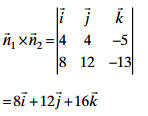Correct option is (a) (x - 1)/2 = (y - 2)/3 = z/4
Explanation :
Let L be the line of intersection. We know that vector n1 = (4,4,-5) and vector n2 = (8,12,-13) are the normals of the given planes. Therefore, the DRs of the line L is

Therefore, the DRs of L is (2, 3, 4). Also, substituting z = 0 in both plane equations, we get
4x + 4y = 12 and 8x + 12y = 32
Solving these equations, we get x = 1 and y = 2. Hence, (1, 2, 0) is a point on the line L. Thus, the equation of the line is
(x - 1)/2 = (y - 2)3 = (z - 0)/4